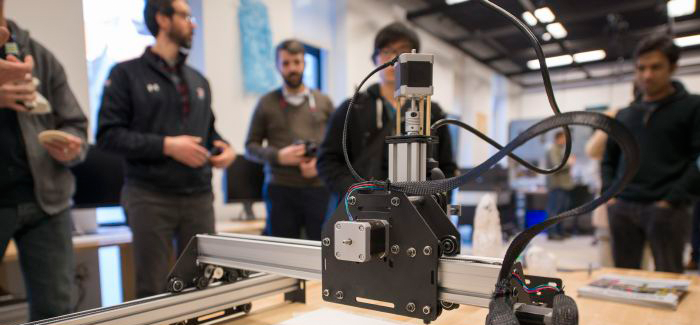
In the Hack Arts Lab, a desktop CNC mill is available for cutting projects. (Photography by Robert Kozloff)
The Hack Arts Lab, celebrating a year on campus, offers tools for the digitally creative.
When Jason Salavon—who makes art with data—arrived at UChicago as an assistant professor of visual arts in 2007, he felt like something was missing. Looking for a laser cutter and a 3-D printer, he found such equipment scattered around campus, mostly in science labs.
“We need a maker space,” said Salavon, who is also a fellow in the Computation Institute. With broad-based support from arts, sciences, and humanities partners, the Hack Arts Lab (HAL) became a reality in 2013.
HAL offers every tool that a technically savvy artist—or a visually inclined hacker—could hope for. There’s a 3-D printer and a laser engraver/cutter, a replicator and a digitizer, software for creative projects, and more. Most services are free, and HAL, located in room 206 in the Searle Chemistry Laboratory, is open to students, faculty, and staff five days a week.
“Our staff may or may not be able to help you with a really complex project. But the ethos is, come in with an idea, and let’s all try to figure out ways to make it,” said Salavon at a February 6 open house celebrating HAL’s first anniversary.
Guests at the open house sipped wine while watching a MakerBot digitizer scan small physical objects like a tape measure. They examined intricate paper-doll clothing and a plastic T. rex made by laser and 3-D printers, and took turns swiping a giant interactive touch screen.
Campus dignitaries like Ian Foster; Matthew Tirrell; William Michel, AB’92, MBA’08; and Martha Roth—respective heads of the Computation Institute, Institute for Molecular Engineering, Logan Center for the Arts, and the Humanities Division—got a firsthand look at HAL’s capabilities. Salavon thanked them for supporting the project from its outset.
Before making a toast, Roth noted that HAL and the computer in 2001: A Space Odyssey share a name. “The original HAL 9000 had a lot of interesting capabilities: facial recognition, lip reading, murder,” said Roth, drawing a laugh from the crowd. The University’s new maker space is meant to be a collaborative venture, she added, with capabilities that science fiction writers a half century ago could not have imagined.
